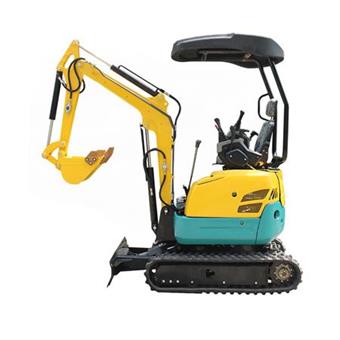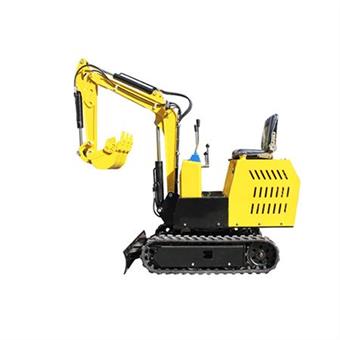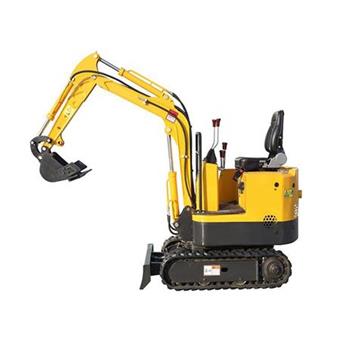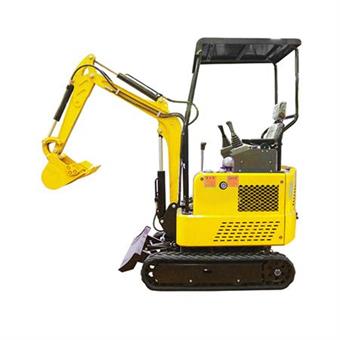
Nachrichten
Wenn Sie sich fragen, wie viel ein chinesischer Minibagger kostet, sind Sie nicht allein. Dies ist eine der am häufigsten gestellten Fragen von Bauunternehmern, Landschaftsgärtnern, Landwirten und Kleinunternehmern, die ihr Budget schonen möchten, ohne dabei Abstriche bei der Leistungsfähigkeit zu machen. In diesem Leitfaden schlüsseln wir die tatsächlichen Kosten auf, erläutern, wie diese Zahlen zustande kommen, und zeigen, wie Sie eine kluge Kaufentscheidung treffen können.
Wenn von einem "Minibagger" die Rede ist, sind damit in der Regel Maschinen im Bereich von 0,5 bis 5 Tonnen (oder manchmal bis zu 6 Tonnen) gemeint, die für enge Räume, leichte Bauarbeiten, Landschaftsbau, Versorgungseinrichtungen oder Arbeiten in Wohngebieten konzipiert sind. Alles, was darüber liegt, wird als "Standardbagger" bezeichnet. Die kleineren Modelle sind leichter zu transportieren, verbrauchen weniger Kraftstoff und sind oft günstiger.
Mit "chinesischem Minibagger" meinen wir einen Bagger, der in China hergestellt (oder montiert) wird, oft von chinesischen Firmen oder Joint Ventures, und der international exportiert wird. Diese Maschinen können lokale chinesische Markennamen tragen oder globale Marken, die die Produktion nach China auslagern. Sie sind nicht unbedingt von schlechterer Qualität, aber es gibt mehr Unterschiede in Bezug auf Qualität, Support und Zertifizierung als bei etablierten globalen Marken.
Nicht alle chinesischen Minibagger sind gleich. Zwei Maschinen, die sich als "1,5-Tonner" bezeichnen, können sich in Bezug auf Motor (Marke und Emissionskonformität), Hydraulikkomponenten, Stahlqualität, Steuersysteme und Anbaugeräte erheblich unterscheiden. Auch Zertifizierungen wie EPA, CE oder Euro V verursachen zusätzliche Kosten. Vergleichen Sie also immer "Äpfel mit Äpfeln".
Hier ist ein realistisches Bild der Preisspannen, die Sie im Jahr 2025 sehen könnten, basierend auf Online-Angeboten, Exportkatalogen und Branchenberichten.
Mikro (0,5 - 1,5 Tonnen)
Diese kleinsten Modelle werden häufig für Gartenarbeiten, leichte Grabarbeiten oder enge Räume eingesetzt. Auf chinesischen Exportplattformen sind einige Maschinen dieser Klasse mit 1.800-3.500 US$ gelistet.
Seien Sie vorsichtig bei extrem niedrigen Preisen; möglicherweise fehlen wichtige Funktionen oder es werden minderwertige Komponenten verwendet.
Mini (1,5 - 3 Tonnen)
Dies ist für viele Käufer ein idealer Bereich: genügend Leistung für echte Arbeit, aber immer noch überschaubare Größe. Chinesische Modelle in diesem Bereich sind oft zwischen 4.500 und 15.000 US$ gelistet, je nach Ausstattung und Exportfähigkeit.
Einige Premium-Versionen oder stark angepasste Versionen können darüber hinausgehen.
Kompakt / Midi (3 - 5+ Tonnen)
Wenn man aufsteigt, steigen die Kosten. Für chinesische Modelle im Bereich von 3 bis 5 Tonnen können die Preise zwischen 10.000 und 25.000 US$ oder mehr liegen, vor allem, wenn die Maschine viele Anbaugeräte, eine klimatisierte Kabine oder eine zusätzliche Hydraulik hat.
Auf Märkten wie den USA oder Europa kostet ein zuverlässiger Minibagger einer großen Weltmarke oft zwei- bis dreimal so viel wie ein chinesisches Basismodell mit ähnlicher Tonnage. Der Preisaufschlag spiegelt die stärkeren Support-Netzwerke, die etablierte Ersatzteilversorgung und den vertrauenswürdigen Markennamen wider. Dennoch kann ein gut ausgewähltes chinesisches Modell die Lücke schließen, wenn Sie vorsichtig sind.
Bei der Bewertung eines Angebots sind dies die Hebel, die die Kosten nach oben oder unten drücken.
Motortyp, Leistung und Einhaltung der Emissionsvorschriften
Ein wichtiger Faktor für den Preis ist der Motor. Ein lokal bekannter oder Markenmotor (z. B. Yanmar, Kubota, Cummins) mit EPA-/Euro V-Konformität erhöht die Kosten. Qualitativ minderwertige oder nicht zertifizierte Motoren senken die Kosten, können aber mit Einschränkungen oder schlechter Leistung verbunden sein.
Hydraulik, Anbaugeräte und Funktionen
Wenn Ihre Maschine über hydraulische Schnellwechsler, mehrere Zusatzkreise, einen Schwenkausleger, einen hydraulischen Daumen, zusätzliche Schaufeln oder eine Kabine mit Klimaanlage verfügt, müssen Sie mit einem Preissprung rechnen. Einfachere Maschinen ohne all diesen Schnickschnack sind billiger.
Verarbeitungsqualität, Materialien, Ruf der Marke
Höherwertiger Stahl, engere Toleranzen, bessere Schweißnähte und eine Marke mit einem guten Ruf kosten mehr. Einige chinesische Marken zeichnen sich durch seriöse Qualität aus, andere sind eher billig.
Versand, Einfuhrzölle und Logistik
In den seltensten Fällen kaufen Sie nur die Maschine - Sie müssen sie von China zu Ihrem Bestimmungsort bringen. Seefracht, Binnentransport, Zoll und Hafenabfertigung können je nach Standort 1.200 bis 2.500 US$+ pro Einheit ausmachen.
Kundendienst, Garantie, Ersatzteile
Maschinen mit soliden Garantien, Ersatzteilversorgungsnetzen und lokalen Händlern kosten im Vorfeld mehr, können aber im Nachhinein Geld und Kopfschmerzen sparen. Billige Maschinen ohne Support können langfristig mehr kosten.
Schauen wir uns konkrete Beispiele an, um die Erwartungen zu verankern.
Fabrik direkt / China Export Listings
Einige Micro / 0,8-1,5 Tonnen Bagger Inserate zeigen US$ 1.800 - 3.500 Bereich.
Für größere Einheiten mit einer Kapazität von 2-3 Tonnen geben einige Firmen US$ mit 9.000-15.000+ an, je nach Zusatzausstattung.
YUFAN (ein chinesischer Hersteller) gibt an, dass seine Maschinen je nach Konfiguration zwischen 2.300 und 20.000 US$ liegen.
Yufan Maschinenpark-Yuanwang
Importeure/Händler in den U.S.A./Europa
Auf US-Plattformen habe ich einen chinesischen Minibagger 1 Tonne Modell um US$ 4.399 mit kostenlosem Versand aufgeführt.
Dieser Preis enthält Aufschläge für den Inlandsvertrieb und den Versand.
Gebrauchte / überholte chinesische Minibagger
Gebrauchte Maschinen können je nach Betriebsstunden, Zustand und Verfügbarkeit von Ersatzteilen für weit weniger gehandelt werden. Einige "gebrauchte/neue" chinesische Geräte erscheinen in Katalogen zu US$ 1.500 - 4.000 in reduziertem oder überholtem Zustand.
Bei gebrauchten Maschinen ist das Risiko jedoch höher, daher sollten Sie sie sorgfältig prüfen.
Beobachtungen zum Online-Marktplatz
Auf Alibaba werden 1-Tonnen-Minibagger zwischen US$ 1.800 - 2.000 (Fabrik-/Großhandelspreis) für Grundmodelle gelistet.
Alibaba
Auf Made-in-China werden einige supergünstige Mikromodelle zu einem Preis von 2.000-2.900 US$ für Basisgeräte angeboten.
Dabei handelt es sich um Basiszahlen; die tatsächlichen Endkosten für Sie werden höher sein.
Bei der Budgetierung vergessen viele Menschen all die versteckten Kosten oder Nebenkosten. Das ist es, was Ihre Marge auffrisst.
Schifffahrt und Logistik (Seefracht, Landverkehr)
Sobald Ihre Maschine in China fertig ist, müssen Sie sie über die Weltmeere und dann auf dem Landweg zu Ihrer Baustelle oder Ihrem Händler transportieren. Allein die Seefracht kostet oft zwischen 1.200 und 2.500 USD pro Einheit, je nach Volumen, Entfernung, Containergröße und Zielhafen.
Wenn Sie mehrere Maschinen in einem 40-Fuß-Container importieren, können Sie diese Kosten auf die einzelnen Maschinen verteilen.
Einfuhrabgaben, Zölle, Zoll
Je nach Land fallen Einfuhrzölle, Mehrwertsteuern, Zollabfertigungsgebühren und Kosten für die Einhaltung von Vorschriften an. Diese können die Kosten für die Einfuhren um 10%-30% oder mehr erhöhen.
Versicherung, Registrierung, Einhaltung lokaler Vorschriften
Sobald es Ihren Hafen oder Ihr Land erreicht hat, müssen Sie es möglicherweise registrieren, versichern oder Sicherheits-/Emissionssysteme nachrüsten, um den örtlichen Gesetzen zu entsprechen. Diese Kosten sind nicht unerheblich.
Betriebskosten (Kraftstoff, Wartung, Ersatzteile)
Selbst eine gut gebaute Maschine hat wiederkehrende Kosten: Kraftstoff, Hydraulikölwechsel, Filter, Routinewartung, Verschleißteile (Raupen, Bolzen, Löffel). Wenn die Maschine weniger gängige Komponenten verwendet, kann die Knappheit der Teile die Kosten in die Höhe treiben.
Abschreibung, Wiederverkaufswert
Eine billigere chinesische Maschine kann sich schneller abnutzen, vor allem wenn die Marke oder der Support schwach sind. Die "wahren Kosten pro Jahr" können also höher sein.
Hier erfahren Sie, wie Sie einen klugen Kauf tätigen und Kaufreue vermeiden können.
Überprüfung von Herstellern und Zertifizierungen
Fragen Sie immer nach Referenzen, Werksprüfungen, CE/EPA/ISO-Zertifikaten und Beispielen von im Ausland eingesetzten Maschinen. Ein glaubwürdiger Hersteller oder Exporteur sollte Ihnen diese zur Verfügung stellen.
Vergleich von "Spezifikation für Spezifikation" statt nur des Preises
Vergleichen Sie nicht nur den Angebotspreis. Vergleichen Sie Pferdestärken, Pumpendurchfluss, Hydraulikdruck, Anzahl der Kreisläufe, Schaufelausbruch, Stahlstärke, Marke der Komponenten usw. Eine billigere Maschine mit schwächeren Spezifikationen kann auf lange Sicht teurer sein.
Anforderung von Musterstücken / Werksbesichtigungen
Wenn möglich, fordern Sie ein Muster an oder besichtigen Sie eine ähnliche Maschine vor Ort. Der Besuch von Fabriken (wenn Sie große Mengen importieren) gibt Ihnen Einblick in die Qualitätskontrolle.
Aushandeln von Großaufträgen oder Anreizen
Viele chinesische Hersteller bieten Rabatte oder Vergünstigungen an (kostenlose Zusatzteile, längere Garantie), wenn Sie mehrere Geräte bestellen oder Händler werden. Fragen Sie immer nach.
Das Kleingedruckte der Garantie und die Ersatzteilversorgung verstehen
Lesen Sie sich die Garantie genau durch - was ist abgedeckt, was nicht, wie lange dauert sie und ist übertragbar. Prüfen Sie auch die Lieferzeiten für Ersatzteile: Wenn Sie monatelang auf eine wichtige Komponente warten müssen, sind Ausfallzeiten wertlos.
Vor- und Nachteile der neuen chinesischen Minibagger
Vorteile: geringere Anschaffungskosten, moderne Funktionen, Garantie, neue Lebensdauer
Nachteile: Risiko schlechter Qualität oder von Mängeln, potenzielle Probleme mit Ersatzteilen, mögliche Probleme mit Vorschriften/Nichtzertifizierung
Wenn Sie sich für eine renommierte Marke mit gutem Support entscheiden, kann ein neues chinesisches Modell sehr günstig sein.
Wann eine gebrauchte, renommierte Marke besser ist
Manchmal kann eine gut gewartete Gebrauchtmaschine einer globalen Marke (Komatsu, Caterpillar usw.) mittelfristig die sicherere Wahl sein. Der Nachteil sind die höheren Anschaffungskosten, aber die bessere Vorhersehbarkeit von Ersatzteilen und Wiederverkauf.
Hybride oder gebrauchte chinesische Geräte
Einige Käufer importieren ein neues chinesisches Fahrgestell und fügen bekannte Komponenten (Motor, Hydraulikpumpen) von vertrauenswürdigen Marken hinzu. Oder sie überholen ältere Maschinen mit besseren Teilen. Diese Hybride können Kosten und Zuverlässigkeit in Einklang bringen.
Anwendungsfälle und Eignung für Ihr Budget
Wenn Sie nur gelegentlich oder mit geringem Aufwand arbeiten, kann ein preiswerteres chinesisches Gerät ausreichend sein. Wenn Sie viel arbeiten, eine hohe Betriebszeit haben oder auf Zuverlässigkeit angewiesen sind, sollten Sie sich für stärkere Marken oder Maschinen mit höheren Spezifikationen entscheiden.
Wenn Sie fragen: "Wie viel kostet ein chinesischer Minibagger?", lautet die Antwort: Das kommt darauf an. Aber mit den oben genannten Spannen können Sie realistische Erwartungen festlegen und überraschende Kosten vermeiden.
Hier ist eine Checkliste für Entscheidungen:
Definieren Sie Ihre Tonnage und Ihren Auftragsbedarf - kaufen Sie nicht zu viel und nicht zu wenig.
Listen Sie die wichtigsten Merkmale auf - Motor, Hydraulik, Anbaugeräte, Emissionen.
Holen Sie mehrere Angebote ein (Spezifikation für Spezifikation) - vergleichen Sie Äpfel mit Äpfeln.
Berechnen Sie die Einstandskosten - Maschine + Versand + Zölle + Einhaltung der Vorschriften.
Prüfen Sie Support / Ersatzteile / Garantie - fragen Sie nach Unterstützung.
Beginnen Sie mit einem kleinen Produkt oder einem Muster - kaufen Sie erst eines, bevor Sie viele bestellen.
Wenn es sich um einen mittelschweren Auftrag handelt, können Sie davon ausgehen, dass ein anständiger chinesischer Minibagger (1,5-3-Tonnen-Klasse) je nach Ausstattung und Region zwischen 5.000 und 15.000 US$ kostet, sobald er im Land ist. Für Kleinst- oder Einsteigergeräte können Sie sogar mit US$ 2.000-4.000 rechnen (allerdings mit Einschränkungen). Nutzen Sie unseren Leitfaden, um Angebote zu kalibrieren.
Ein chinesischer Minibagger ist eine verlockende Option für kostenbewusste Käufer. Aber der Aufkleberpreis ist nur der Ausgangspunkt. Die Kosten hängen stark von der Größe, den Merkmalen, der Motor- und Emissionszertifizierung, dem Versand, den Einfuhrzöllen und dem Kundendienst ab. Wenn Sie gründlich vorgehen, d. h. die Spezifikationen vergleichen, die Hersteller prüfen, die Logistik berücksichtigen und den Kundendienst in Anspruch nehmen, können Sie eine Maschine kaufen, die ein ausgewogenes Verhältnis zwischen Erschwinglichkeit und Zuverlässigkeit bietet. Nutzen Sie diesen Leitfaden als Grundlage für die Bewertung von Angeboten und für Ihre Kaufverhandlungen.
Q1: Kann ich wirklich einen hochwertigen Minibagger aus China für weniger als 5.000 US$ bekommen?
A1: Ja - einfache Mikro-/Kleinmodelle werden manchmal mit Preisen zwischen 1.800 und 3.500 US$ ab Werk angegeben. Aber in diesen Zahlen sind Versand, Zertifizierung und notwendige Komponenten oft nicht enthalten. Seien Sie vorsichtig - Sie müssen die Qualität, die Teile und den Support in der Praxis überprüfen.
F2: Wie hoch sind die Kosten für Seefracht und Einfuhrzölle normalerweise?
A2: Der Versand einer Einheit kann US$ 1.200 - 2.500+ kosten, und die Einfuhrzölle/Steuern können je nach Land weitere 10-30% oder mehr betragen.
Holen Sie immer Fracht- und Zollangebote ein, um die tatsächlichen Kosten zu ermitteln.
F3: Welche Tonnage ist für die meisten kleinen Unternehmen oder Landschaftsbauaufträge optimal?
A3: Viele Käufer sind der Meinung, dass Minibagger mit einer Tonnage von 1,5 bis 3 Tonnen genau das Richtige sind - sie bieten sinnvolle Grabungsmöglichkeiten, ohne übermäßig groß oder teuer zu sein. Aber Ihr spezifischer Einsatz (Tiefe, Breite, Hub) sollte Sie mehr leiten als die Tonnage allein.
F4: Sollte ich eine bekannte globale Motormarke den billigeren chinesischen Motoren vorziehen?
A4: Bekannte Motoren (Yanmar, Kubota usw.) sind oft teurer, bieten aber Zuverlässigkeit und Verfügbarkeit von Ersatzteilen. Ein billiger Motor kann anfangs Geld sparen, kostet Sie aber Ausfallzeiten oder Reparaturen. Es hängt davon ab, wie wichtig die Zuverlässigkeit für Ihre Anwendung ist.
F5: Ist es riskant, einen gebrauchten chinesischen Minibagger zu kaufen?
A5: Es besteht ein größeres Risiko, da die Vorgeschichte, die Verfügbarkeit von Teilen und die Wartung unbekannt sind. Wenn Sie eine sorgfältige Inspektion durchführen, die Betriebsstunden überprüfen, Verschleißteile kontrollieren und sich vergewissern, dass Ersatzteile vorhanden sind, kann ein gebrauchtes chinesisches Gerät lebensfähig sein - aber es erfordert mehr Sorgfaltspflicht.



